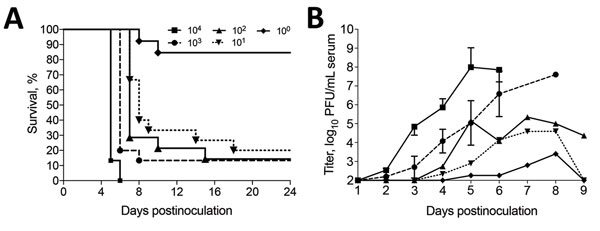Volume 22, Number 12—December 2016
Research
Vertebrate Host Susceptibility to Heartland Virus
Figure 1

Figure 1. Dose response of Heartland virus (HRTV)–infected interferon α/β/γ receptor–deficient (Ag129) mice. Mice of either sex were inoculated with 104–10° PFU of HRTV/0.1 mL of inoculum. Mice were observed daily for death through day postinoculation 24. A) Percentage survival. B) Dose-associated HRTV viremias determined by plaque assays on Vero E6 cells. Different groups of 5 mice inoculated with the same dose of HRTV were bled every third day. Thus, a decrease in viremia was observed for the 102 PFU dose inoculum group days postinoculation 5 and 6. Error bars indicate SD.
Page created: November 17, 2016
Page updated: November 17, 2016
Page reviewed: November 17, 2016
The conclusions, findings, and opinions expressed by authors contributing to this journal do not necessarily reflect the official position of the U.S. Department of Health and Human Services, the Public Health Service, the Centers for Disease Control and Prevention, or the authors' affiliated institutions. Use of trade names is for identification only and does not imply endorsement by any of the groups named above.